An in- depth and honest guide to visiting the Amalfi Coast.
Where to stop, where to stay, where to eat, and where to see the best views.
You can't think of Southern Italy without dreaming of a trip to the Amalfi Coast. The most beautiful places in Campania have always been linked, in the collective imagination of dreamers and travelers alike, to the typically Mediterranean landscapes, flavors and warmth of the people.
In other words the Amalfi coast is sun, sea, pizza, clothes hanging on balconies, and loud cheerfulness.
In this article we have approached the region as a single destination, as well as provided a deep dive into the individual must- see places. The breakdown is important because, at least for the majority of Italians, the unique towns represent more than just a weekend destination, and each one deserves an authentic vacation at a slow pace to savor unforgettable landscapes, history and gastronomy.
How to explore the area
Let’s start with how to get there. Surely the best way to get around the Amalfi Coast is by car, so you can freely roam the winding roads overlooking the sea.
Although it is not necessarily the best way to travel for everyone! The road from Naples circumnavigates the Sorrentine Peninsula and descends to Salerno (it is in fact one of the most spectacular roads in the world).
The speed limit is about 20 km/h, so from Positano to Amalfi, just a 24 km (14 mile) drive, takes about an hour. During the autumn and winter seasons, the road conditions can cause serious difficulties for visitors who have rented a car and ventured to brave the impervious bends. It's not uncommon to find them stopped around curves, in crisis at crossroads or in a total panic when they see a bus coming from the opposite direction! To avoid any mishaps or frustration, experienced guides recommend hiring a driver. We are inclined to agree that the most convenient, and less stressful, solution to get to the coast (especially if you are traveling in a group and with luggage) is to book a private transfer from the airport, be it Rome or Naples, that transports you directly to your hotel. However, for those determined to rent a car and drive, the splendid views are worth it (here are other travel options to consider provided further on).
What to consider before your visit
Now, the Amalfi Coast is one of the most beautiful places in the world. In 1997 it rightly earned its title as a World Heritage Site. However, it is not the place for everyone!
The Coast is not an easy- going seaside experience. You won’t find lounge chairs on large sandbars, or noisy water games, pedal boats or big establishments.
In fact, you can count the “real” beaches on one hand, and reaching them sometimes requires legs (and hearts) of steel to conquer the dizzying ups and downs to reach them. The positions of these few beaches (which are almost more like coves) mean the sun disappears in the early afternoon, hiding behind rocky mountains, and leaving beachgoers in the shade.
In the summer, therefore, the Amalfi Coast should be experienced in picturesque swimming pools, which often provide panoramic views, and with which almost all hotels are equipped. Then, the real voyage starts: with a leisurely stroll, a luxuriously simple aperitif and an unforgettable dinner.
The historic hotels dotted along the Amalfi Coast have become a symbol of Italian style around the world, and are literally life- changing for those who have the honor of staying in one. A wonderful panoramic- pool- touting hotel overlooking Positano that we recommend is the Hotel Le Sirenuse. You will never want to leave! Between the view, the candle-lit restaurant and the unique hospitality, you’ll never want to leave!
If you are considering traveling to the Amalfi Coast with children, be warned: the Coast is a place for elopements, romantic dinners and sweet idleness. The surrounding beauty, the scent of lemons and Mediterranean flavors, the impeccable customer service (and the difficult and expensive parking) are, in our opinion, best experienced in pairs.
Where to stop for the best photographs
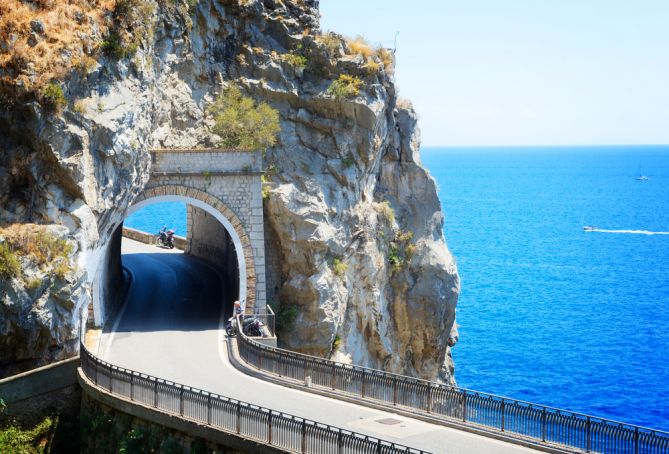
The most beautiful stretch of the trip is the part that goes from Positano, the pearl of the Coast, to Amalfi, with an inevitable stop in Ravello, at the top of the rocky point jutting out of the sea.
Positano is the most coveted and exclusive destination of the entire coast, that leaves visitors speechless for its beauty and elegance. During the day, it is invaded by "touch and go" tourists, its hotels are a favorite destination for weekend jaunts and vacations of affluent travelers. The shade- covered streets of the town center, splattered on winding hills, are home to boutiques, art galleries and craft stores with local products famous throughout the world, from soldering irons to linen clothes, to gastronomical delights. The beach, with its brown sand and heat in the height of summer, is counted as the best of the entire Amalfi Coast. The best photo, apart from the one from the terrace of Hotel Le Sirenuse and from the beach, can be taken along the road that continues towards Praiano, a few bends after Hotel San Pietro, another elite meeting place on the coast with direct access to the sea.
Driving from Positano to Amalfi is an authentic experience, to be done calmly. Stop in the (very few) shoulder lanes to admire the landscape, and savor the view that appears from behind every curve.
The first village that you will come across on your drive is Praiano, smaller than Positano and identifiable by the beautiful and colorful dome of the Church of S. Maria a Castro, from where the vantage point embraces the coast in all its splendor, up to Positano and, in the background, the Faraglioni of Capri.
Immediately afterwards, you can reach Marina di Praia, a spectacular little beach at the end of a narrow passage between the rocky walls that descend from high until they touch the water. There are guarded parking lots so you can reach it directly by car, and there are restaurants where you can eat fish. The only flaw, which in the sultry days of August can perhaps become an advantage, is that the sun shines only for a few hours on the cove. For lunch, book Armandino's.
Must- see points of interest
Back on the road, a little further on, you will arrive at a bottleneck and a bridge overlooking the Fiordo di Furore (see photo), a magnificent place that unfortunately today is no longer accessible due to some landslides from the mountain.
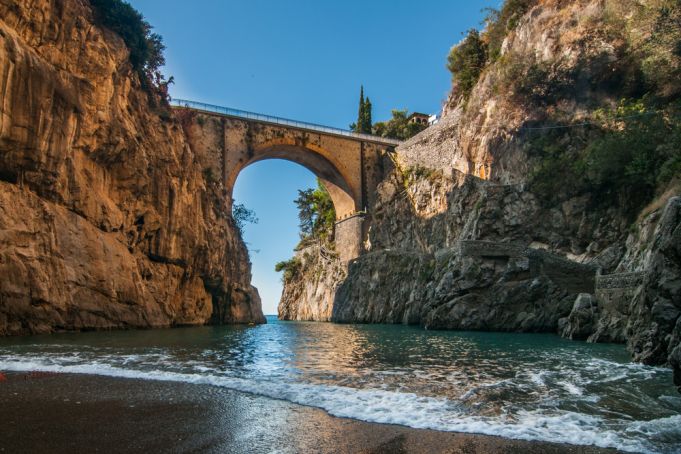
From there, in just a few minutes you will reach Amalfi, the "capital" of the Coast, noisy and lively, proud to have been one of the Four Maritime Republics. Unlike Positano, it is a real town, with a magnificent cathedral, that of Sant'Andrea, characterized by a winding staircase, and a small port from where boats and ferries depart.
Next to Amalfi, is Atrani, the smallest town in Italy, and on the list of the most beautiful Italian villages and also a World Heritage Site. It is almost impossible to recognize the difference from Amalfi, because Atrani is practically a natural extension of its center. And in fact, it takes only two bends along the coastal road to reach the beach of Atrani, where you enter the tiny historic center, practically a small squaret. But, if you're in the mood for a bite, stop by Le Palme for a plate of pistachio and shrimp pasta.
Finally, to complete the tour, you cannot miss Ravello. Cultured and refined with its historic villas and events known throughout the world, a meeting place for artists and cultural figures, elegantly aristocratic, quiet and with the knowledge that it has a lot of charm to offer. Nestled on top of the mountain overlooking Amalfi (from which it is about 10 minutes away), with breathtaking views of Minori and Maiori and beyond to the Gulf of Salerno, this town is the perfect alternative to Positano as a place to stay.
Try your luck with a booking Villa Fraulo, an elegant four-star hotel with a magnificent terrace, right in the center. Next to it are Ravello's other luxury hotels, including the very luxurious Caruso, all developed in historic Moorish-style buildings along the same street, overlooking the sea. Ravello, beyond the beautiful little square of the Duomo, hides two places which alone deserve a trip to the Coast: Villa Rufolo and Villa Cimbrone. The first must be seen in the afternoon, and the second in the morning for the most beautiful photos.
Villa Rufolo, in the heart of Ravello, was the home of one of the most powerful families of the 13th century, the Rufolos, and is still today an extraordinary example of architecture and botanical art. From its gardens you can enjoy a breathtaking view and, before the sun dips behind the mountain, you can snap one of the most quintessential images of the Coast: the two Moorish domes topped by a large pine tree at the end of the gardens of the villa, with the coast of Maiori at your feet.
Villa Cimbrone, on the tip of the mountain, is now a luxury hotel. You can still tour almost all of it, and it deserves to be visited both for the magnificent gardens and for the famous Belvedere which you reach at the end of the shady avenue of the park. It is a large terrace overlooking the sea, hanging over the hill, and adorned with ancient bust sculptures. It has bewitched celebrities of the international jet set, as well as having been the meeting place for Greta Garbo and her lovers. You can admire a unique view of the sea and the lemon growers all around from this historic villa.
Don't miss the chance to dine in one of Ravello's restaurants with a view (make a reservation for the terrace of Hotel Garden), perhaps early in the evening to admire the lights of the villages twinkling all around you as the sun sets.
To conclude your trip to the Amalfi Coast, you cannot miss a visit to one of the many limoncello distilleries. Take a bottle of the famous liquor home with you not as a souvenir, but to possess the unique flavors and smells of this unforgettable land.
If you would like to dive further into the splendid towns and history of the Amalfi Coast, we have created a list of the 13 most beautiful places. Keep reading to discover them!
How to get to the Amalfi Coast
From Rome Fiumicino Airport
From Rome Fiumicino Airport you can take the Leonardo Express, a direct train to Rome Termini Station. Then from here you can take a train to Naples or Salerno. From Salerno, you can take the TraVel Mar ferry for €8 to Amalfi, which takes 35 minutes.
From Rome Termini Station to Salerno
- 1. Eurostar Freccia Rossa (TAV):You can reach Salerno station in about two hours. Trains of this type leave every hour and are on time. The cost is about 40 euros.
- 2. Intercity: these trains will reach Salerno in about three hours. The cost is about 20 euros.
- 3. Interregional: these trains that stop at all stations and in every city. It takes about four hours to travel from Rome to Naples. Don’t make the mistake of getting on one of these! The ticket costs 10 euros.
From Rome to Positano by Private Car
A private car service will cost around 270 euros and will take about three and half hours to reach Positano from Rome. Do not pay in advance and make sure to agree on the price and method of payment before departing.
On the southern shore of the Sorrentino Peninsula, the Amalfi Coast stretches from the Gulf of Naples to the Gulf of Salerno.
Here, the land is recognized for its towering mountains and pebbly shores that are connected to each other by a maze of narrow alleys and steep stairs. Composed of 13 towns and various sun-kissed beaches that overlook the crystal-clear waters of the Mediterranean Sea, the Amalfi Coast has been recognized as a World Heritage Site by UNESCO.
Amalfi
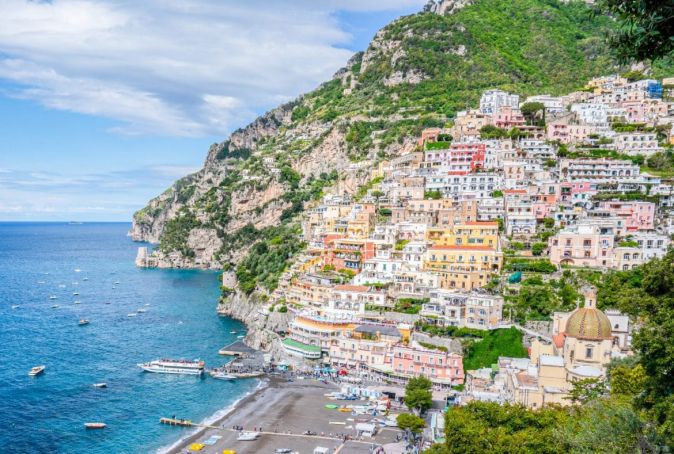
Located at the mouth of the Valle dei Mulini is the town of Amalfi. The village that gives the coast its name. With a long history of politics and trade, Amalfi is known for being the first of the Four Maritime Republics of Italy and, for a long time, claimed a monopoly on trade with the East. Composed of white houses that cling to the rocks on which it was built, the town is connected by narrow pathways and stairways. The grand Cathedral of Saint Andrew towers over the town’s main square, and situated next to the church is the bell-tower, designed to mimic the Arab-Norman style. A short walk from the church and bell-tower is the Cloister of Paradise, a white building marked by its narrow arches that line every wall. In the middle of the Cloister of Paradise is a small garden supporting large palm trees that tower above the building itself. However, these trees are short in comparison to the tower that marks the entrance of the Cloister of Paradise. Founded in 1969 by Nicola Milano, the Handmade Paper Museum can also be located in the town of Amalfi. The museum was once an ancient medieval paper-mill that now displays manuscripts, incisions, posters, documents and a specialized library.
Also Read:
- Monteriggioni in Tuscany
- San Gimignano: A town of fine towers
- The Conero Regional Natural Park
- Most Beautiful Castles in Abruzzo
- The Via Francigena, an ancient pilgrim route
- Visiting Val d’Orcia: our two day guide
Atrani
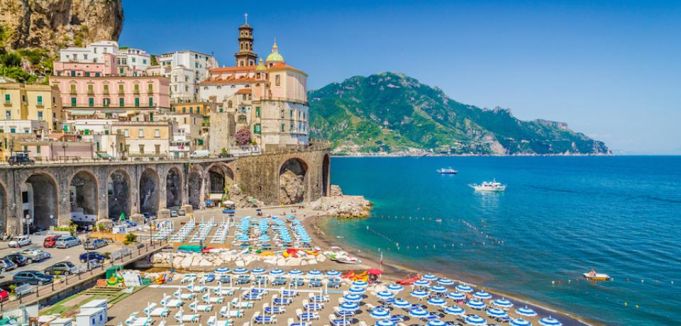
Situated at the opening of the Valle del Dragone is the town of Atrani. This town has been described as a “natural amphitheater on the sea” and offers a relaxing visit away from typical tourist traps. Atrani’s main square sits close to the beach. The 10th centruy Church of San Salvatore de’ Birecto was once used as the location were the investiture of the Doges took place. The church provides an historical and spiritual experience for visitors.
Cetara
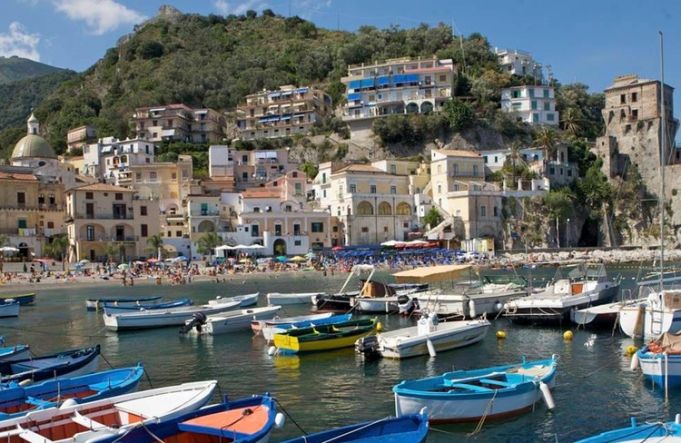
Known for creating culinary specialties like anchovy sauce, the town of Cetara is a fishing village. Built around the town’s main church dedicated to Saint Peter, Cetara continues to be an active fishing port, focusing on the capture and storage of tuna and anchovies.
Conca dei Marini
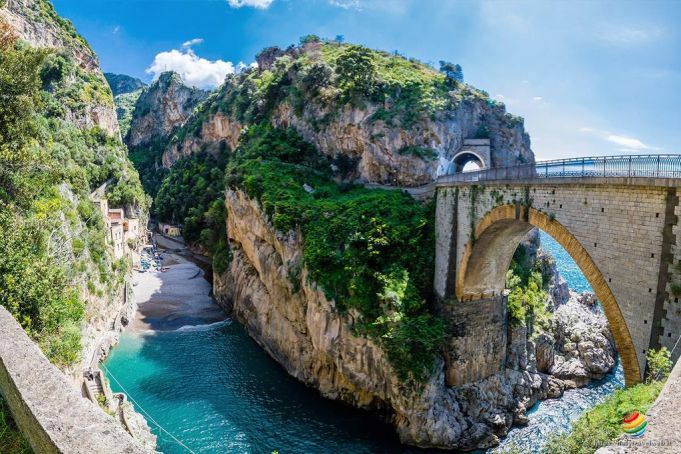
Seen as a natural balcony that overlooks the sea, Conca dei Marini provides a stunning view of the Mediterranean, as well as the surrounding vegetation. Most terraced gardens support the growth of the “Sfusato Amalfitano” lemon groves. Here, the Monastery of Santa Rosa clings to the steep, rocky cliffs that compose the town’s landscape. According to local lore, the monastery is home to the preparation of the sfogliatella Santa Rosa, a hard pastry filled with cream and sometimes fruit.
Furore
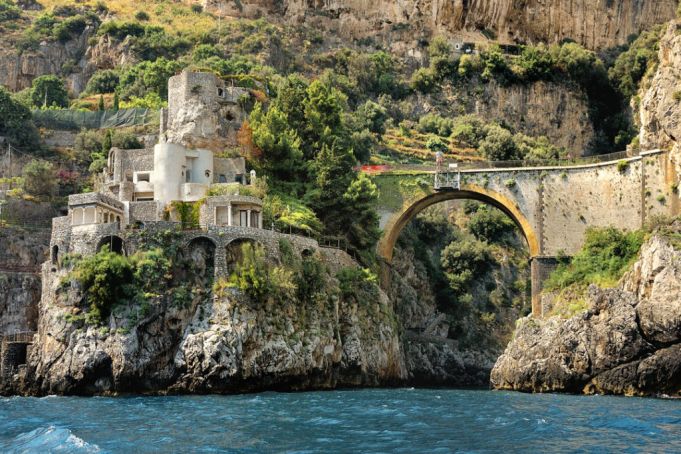
Characterized as being the home of the Fjord, a deep scar in the rock that has been carved out by the Schiato river, is the town of Furore. Also known as “the town that doesn’t exist,” Furore is known by its scattered villages that are surrounded by terraced vineyards. Due to the “en plain air” murals that decorate the white washed houses, Furore has also earned the nickname “the painted village.” The town especially attracts visitors towards the end of June and beginning of July, when it hosts the MarMeeting – High Diving World Championship, a competition that takes place annually on the first Sunday of July.
Maiori
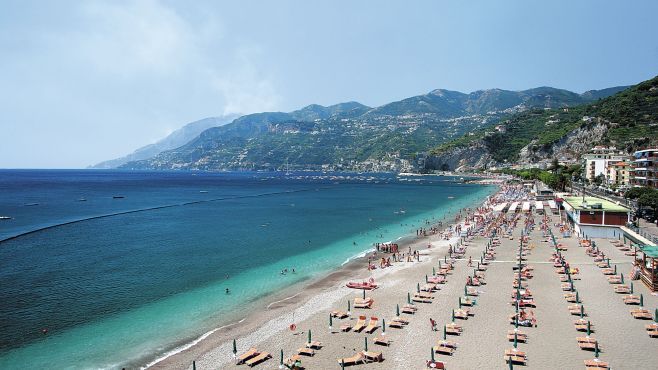
The ancient Reghinna Major is now known as the town of Maiori. Characterized by its wide promenade that separates the Norman Tower on its east side and marina and Miramare Castle on its west side, the town of Maiori became neo-realist director Roberto Rossellini’s favorite movie setting, after World War II. In the center of town, ancient vaulted houses represent the first settlements of this coastal town. Here, ancient history meets the mid-18th century, with Neoclassical buildings that stand in harmony with the homes of the foregone past. The Maiori town center is built around the medieval Fortress of Thoro-Plano, a castle that once served as a bulwark and refuge for the town’s population against attacks by the Lombardy outlaws and Barbary pirates. The Abbey of Santa Maria de Olearia can akso be found along the SS. 163 “Amalfitana,” in the town of Maiori. The 10th centruy church is held up on foundations that were dug into the rocky landscape. Originally built as a church, the Abbey of Santa Maria de Olearia gradually grew into a monastery. After years of multiple additions and construction, the church now holds three different chapels that are stacked on top of each other.
Minori
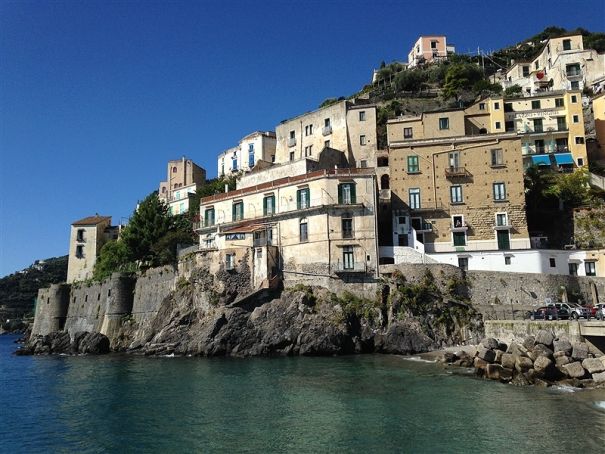
The town of Minori was once an ancient village called Reghinna Minor. It is known for its culinary specialties, such as continuing a long tradition in the production of handmade pasta. The town also plays an important role in the processing the Amalfi Coast Lemon. This lemon is grown in orchards surrounding the town and lining the coast. Amongst the lush greenery are hidden treasures, such as the ruins of the 1st centruy Roman villa, the Basilica of Santa Trofimena and the Arab-Norman bell-tower of Annunziata.
Positano
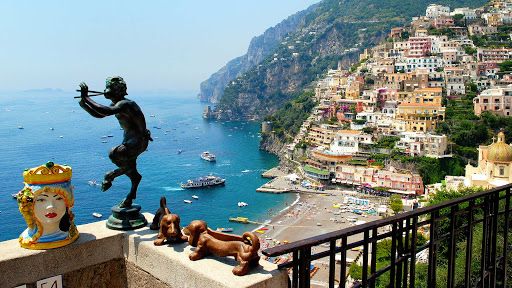
Creating a vertical landscape built into the mountain, Positano is known for its whitewashed houses and narrow stair cases that have attracted international artists following World War II. Most of the town’s buildings were designed in the 19th and 20th centuries and follow the typical Mediterranean architectural style. The picturesque landscape views the Li Galli islands, three solitary islands off of the Positano shores. These islands were once recognized in mythological tales, such as Homer’s Odyssey, for being the home of the Sirens’, bird like creatures with human faces that would lure passing ships into crashing with their hypnotizing song. Positano’s main church is also featured on most postcards and can be recognized by its tiled dome. The town is also known for its fashion. Here, common goods would include hand-made leather sandals, as well as “Moda Positano,” or Positano Fashion, characterized by cotton and linen clothing.
Praiano
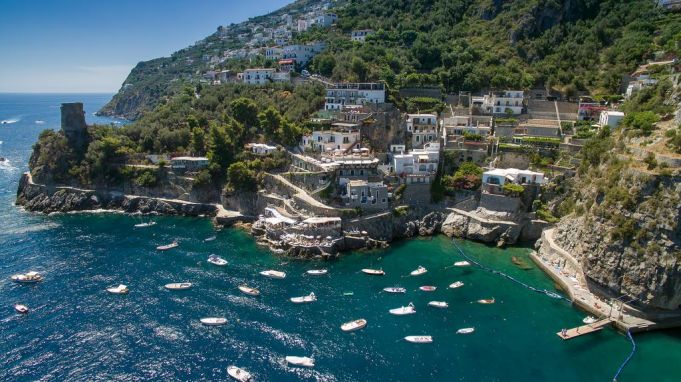
Far from the reaches of mass tourism, the Praiano town is typical of most towns located on the Amalfi Coast. Here, narrow streets guide visitors and locals, alike, through the town’s vegetation and gardens directly to the beach. As the sun begins its descent from the sky, Praiano is the best place to view the purple sun as it vanishes behind the island of Capri.
Ravello
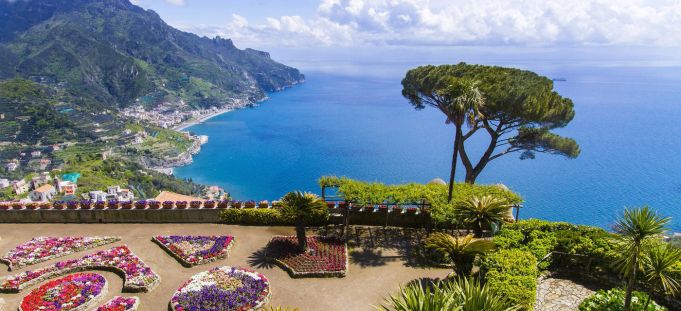
Scala
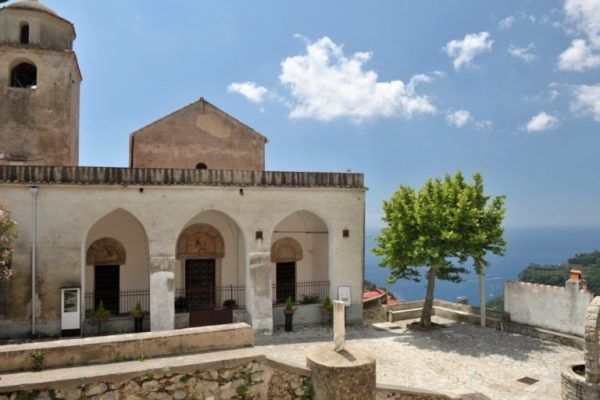
Set in a dense grove of chestnut trees is the oldest town located in the Amalfi Coast, Scala. It is the birthplace of Fra ‘Gerardo Sasso, the founder of the Knights of Malta. Scala’s rich history is preserved in its quite serenity, with historical monuments scattered around the town. One of these monuments being the ruins of the Basilica of Saint Eustachio, which is the largest cathedral in the Duchy of Amalfi. The church looks over the village of Pontone, a hillside district that makes up part of the town. Restorations of the Basilica of Saint Eustachio have preserved the church’s apses, frescoes and skillful marble work.
Tramonti
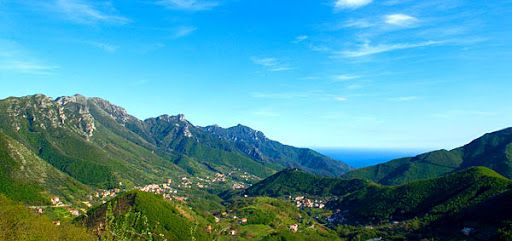
Surrounded by the Lattari Mountains, the town of Tramonti is a hilly town, known for its lush vineyards and chestnut trees. This town is particularly known for its local cuisine and culinary traditions that date back to the Middle Ages. The vineyards produce full-bodied wines, known as Tintore Wine. Local dairy products are also particularly popular, as well as Tramonti’s bread and pizza. The pizza is typically prepared in rural ovens with rye, barley flour and seasonings, such as lard and spices.
Vietri sul Mare
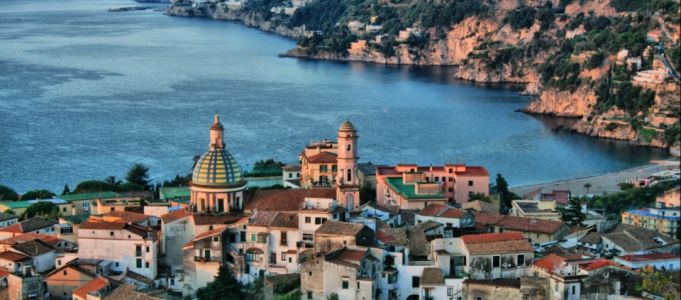
When traveling from Salerno, the town of Vietri sul Mare is the first town making up the Amalfi Coast. In mythological tales, the town was founded by the Greek hero Jason, on his search for the Golden Fleece. In modern times, Vietri sul Mare is known for playing an important role in the production of brightly colored ceramics, a role that has dated back to the 15th century. Some of these ceramic pieces are displayed in the Provincial Museum of Ceramic, housed in the Belvedere Tower. The tower belongs to Villa Guariglia, a house designed by Paolo Soleri in the Neoclassical style.
General Info
View on Map
An in-depth and honest guide to visiting the Amalfi Coast
84011 Amalfi, SA, Italy



















